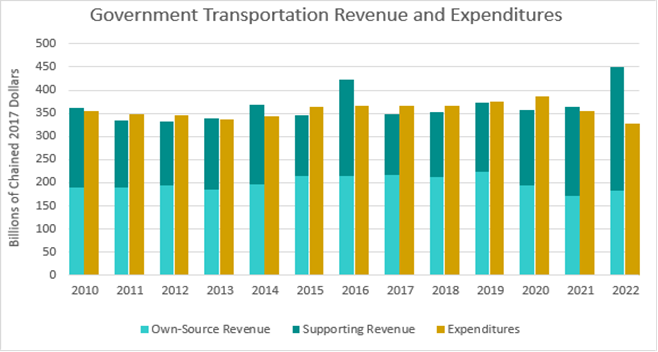A Transportation Finance Statistics MakeoverTuesday, December 31, 2024 Today, the Bureau of Transportation Statistics (BTS) released Transportation Public Finance Statistics (TPFS) final annual estimates for the first time. This release replaces the June preliminary estimate with actuals. TPFS provides information on transportation-related revenue and expenditures for all levels of Government, including Federal, state, and local, and for all modes of transportation. This data program replaced the former Government Transportation Financial Statistics (GTFS). As seen in the chart below, funding available for transportation increased dramatically in 2022. The Bipartisan Infrastructure Law (BIL) dedicated $90.0 billion to the Highway Account of the Highway Trust Fund and $28.0 billion to the Mass Transit Account of the Highway Trust Fund. Those $118.0 billion in funds show up in the Highway Trust Fund and as supporting revenue in 2022. Supporting revenue are funds collected from non-transportation activities but dedicated to support transportation programs. When adjusted for inflation, expenditures continued to decline in 2022, as 2022 marked a year of historically high inflation that will reduce the buying power of BIL in future years.1 As projects move through various stages of approval and design, we expect to see an increase in expenditures from the increased spending in BIL. In June of 2024, BTS released preliminary TPFS state and local estimates for highway revenue, highway expenditures, water revenue and water expenditures. The following summarizes the percent accuracy of each estimated category:
Although the water estimates were less accurate, they represent a significantly smaller portion of total state and local revenue and expenditures, less than 3% of revenues and 2% of expenditures. Estimated state and local highway revenue and expenditures represent 23% of revenues and 27% of expenditures. What's new about TPFS? TPFS expands upon the existing expenditures and revenues of GTFS, by including new data sources, such as the full Amtrak financials. TPFS includes additional categories to address policy questions – including expenditures broken down between capital and non-capital spending, while revenues now show user-based revenues (i.e., transit fares). TPFS also differentiates between Federal cash flows from transportation trust funds separately from general funds. TPFS Products: TPFS Visualizations:
1 https://www.bts.gov/data-spotlight/increases-highway-construction-costs-could-reduce-bil-funding-allocated |
.
Copyright © 2015 : All.Semua



0 Komentar untuk "A Transportation Finance Statistics Makeover"